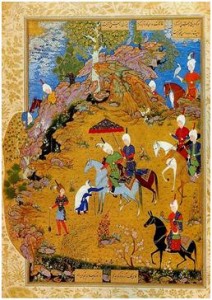PAINTING
Although there has been a tradition of wall-paintings, especially in the Persianate world, the best-surviving and highest developed form of painting in the Islamic world is the miniature in illuminated manuscripts, or later as a single page for inclusion in a muraqqa or bound album of miniatures and calligraphy. The tradition of the Persian miniature has been dominant since about the 13th century, strongly influencing the Ottoman miniature of Turkey and the Mughal miniature in India. Miniatures were especially an art of the court, and because they were not seen in public, it has been argued that constraints on the depiction of the human figure were much more relaxed, and indeed miniatures often contain great numbers of small figures, and from the 16th century portraits of single ones. Recent scholarship has noted that, although surviving early examples are now uncommon, human figurative art was a continuous tradition in Islamic lands in secular contexts (such as literature, science, and history); as early as the 9th century, such art flourished during the Abbasid Caliphate (c. 749–1258, across Spain, North Africa, Egypt, Syria, Turkey, Mesopotamia, and Persia).[17] Figurative wall painting in Mesopotamia, Syria, and Egypt from this earlier time period is also mentioned in the sources.
The largest commissions of illustrated books were usually classics of Persian poetry such as the epic Shahnameh, although the Mughals and Ottomans both produced lavish manuscripts of more recent history with the autobiographies of the Mughal emperors, and more purely military chronicles of Turkish conquests. Portraits of rulers developed in the 16th century, and later in Persia, then becoming very popular. Mughal portraits, normally in profile, are very finely drawn in a realist style, while the best Ottoman ones are vigorously stylized. Album miniatures typically featured picnic scenes, portraits of individuals or (in India especially) animals, or idealized youthful beauties of either sex.
Chinese influences included the early adoption of the vertical format natural to a book, which led to the development of a birds-eye view where a very carefully depicted background of hilly landscape or palace buildings rises up to leave only a small area of sky. The figures are arranged in different planes on the background, with recession (distance from the viewer) indicated by placing more distant figures higher up in the space, but at essentially the same size. The colours, which are often very well preserved, are strongly contrasting, bright and clear. The tradition reached a climax in the 16th and early 17th centuries, but continued until the early 19th century, and has been revived in the 20th.





